There are 11 salamanders in Massachusetts that can generally be found in woodlands and forested areas close to or in freshwater. These water bodies include springs, streams, lake lakes, ponds, rivers, pools, floodplain marshes, and swamps.
So what are salamanders? Salamanders are amphibians in the order Urdoela. These amphibians generally resemble lizards, in particular skinks, in appearance. Although most resemble lizards, they are more closely related to frogs and toads as they are amphibians.
Salamanders may be common within forested areas and woodlands but they can be difficult to spot as they generally remain hidden. They are generally hidden under logs, flat rocks, and in crevices in the ground and rocky terrains.
Table of Contents
Salamanders in Massachusetts
Family Ambystomatidae
1. Jefferson Salamander
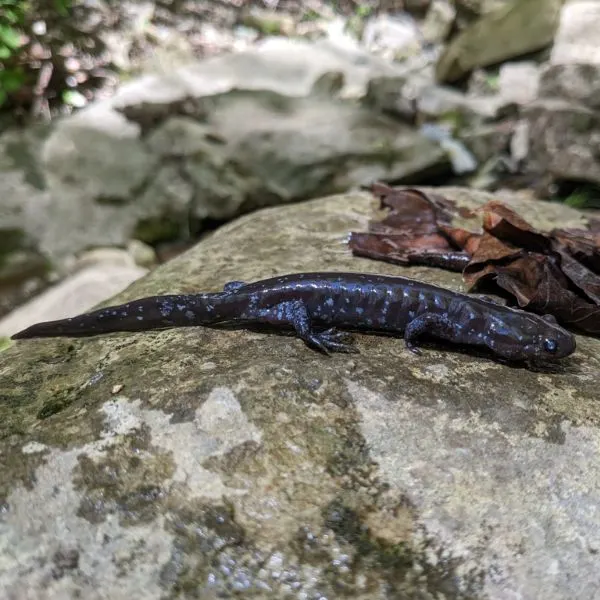
- Binomial Nomenclature: Ambystoma jeffersonianum
- Adult Length: 4 to 7 inches (10 to 18 cm)
- Lifespan: greater than 10 years
- State Status: Special Concern
- Federal Status: None
Ambystoma jeffersonianum is large and quite stocky as it is a mole salamander. The dorsal coloration is grayish brown with silvery or bluish fecks on the tail, lower sides, and legs. The tail is keeled especially in males. This tail makes up about 50% of the total body length. Females are generally larger than males.
In Massachusetts, the species is endemic to Hampden, Hampshire, Franklin, and Berkshire counties. Here the wild population contains unisexual. Outside of Massachusetts, Ambystoma jeffersonianum is endemic to eastern North America from southern Ontario to Virginia. The range extends as far west as Virginia.
The species inhabits mixed deciduous and coniferous forests, woodlands, and mature deciduous forests. Here they commonly breed in vernal pools and shrub swamps.
They do not inhabit other wetlands such as beaver impoundments, floodplain marshes, and red-maple swamps which are used by other species of Ambystomatids. The microhabitat best suited for the Jefferson salamander includes one with rodent burrows, canopy tree cover, loose soils, woody debris, and thick leaf litter.
2. Blue-spotted Salamander
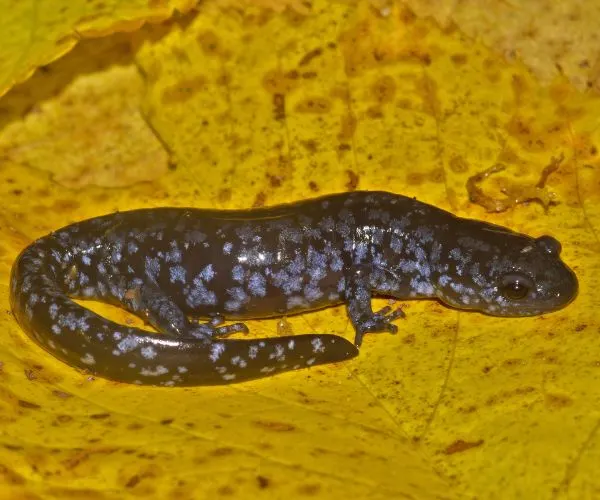
- Binomial Nomenclature: Ambystoma laterale
- Adult Length: 3 to 5 inches (7.5 to 13 cm)
- State Status: Threatened (Bristol/Plymouth counties), Special Concern (Rest of state)
- Federal Status: None
Ambystoma laterale is a moderately sized salamander with blue spots, flecks, and blotches distributed indiscriminately on a black to dark grey background. These blue spots give the species its common name.
Among juveniles, the spots./markings are more evenly distributed over the enter dorsum. Among adults, the spots are concentrated along the sides and limbs. The tail is keeled or laterally compressed. Males have longer tales than females. Similar to other mole salamanders, A. laterale is stocky.
The species is endemic to northeastern North America with most of the population being in the glaciated areas of North America. In Massachusetts, the species is endemic primarily to eastern Worcester, Middlesex, and Essex counties. There are disjunct populations in eastern Hampshire, eastern Hampden, northern Bristol, Plymouth, and Norfolk counties.
The species is terrestrial as adults and are endemic to mixed deciduous and coniferous forests, woodlands, and mature deciduous forests.
They generally inhabit marshy/swampy river floodplains, lowlands, glacial deposits, swamp forests (cedar/maple), and former glacial lakes. A. laterale breeds in marshy/swampy river floodplains, riverine swamps, wooded swamps, shrub swamps, and vernal pools.
3. Spotted Salamander

- Binomial Nomenclature: Ambystoma maculatum
- Adult Length: 5.9 to 9.8 inches (15 to 25 cm)
- Lifespan: 32 years
The spotted salamander gets its common name from the yellow spots on its body. These yellow spots are in two rows and run from the back of the eyes to the tip of the tail.
The background color is generally black. There are individuals with dark brown, dark green, bluish-black, or dark gray background colors. The ventrum/belly of Ambystoma maculatum is pink and gray. Similar to other mole salamanders, Ambystoma maculatum is stout and has a wide snout.
The species is endemic to mixed forests (deciduous and coniferous forests) and hardwood forests. Here the species is always close to aquatic sites such as swamps and vernal pools.
They remain hidden most of the time and are hardly seen except during the breeding season. These amphibians hide in mammal burrows, and under stumps and logs. The spotted salamander prefers lowland forests although they sometimes inhabit open forest edges.
Ambystoma maculatum is endemic to eastern North America from Canadian provinces including Nova Scotia, New Brunswick, Ontario, Prince Edward I., and Quebec to the Coastal Plain of the United States (Georgia, Alabama, Mississippi, Louisiana, and eastern Texas).
4. Marbled Salamander
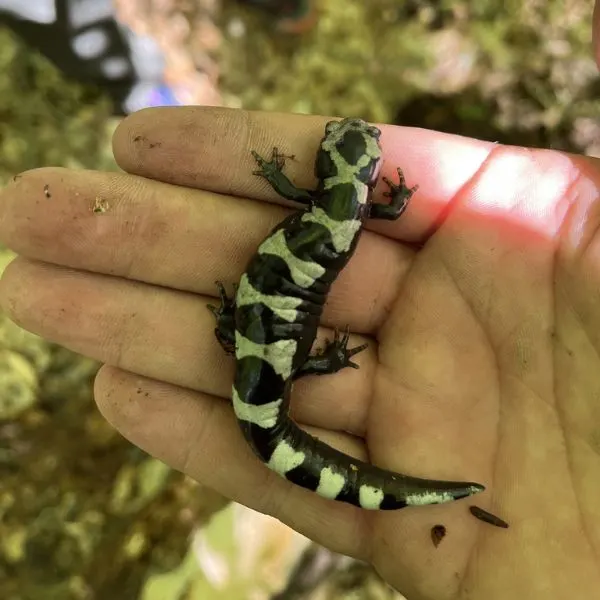
- Binomial Nomenclature: Ambystoma opacum
- Adult Length: 3 to 5 inches
- Lifespan: greater than 10 years
- State Status: Threatened
- Federal Status: None
The marbled salamander is a moderately sized amphibian with a stocky body, unlike most other salamanders. Similar to other salamanders, Ambystoma opacum has short legs.
The snout is broad and rounded. The dorsum coloration is black with silvery white or silvery gray bands that go across the body. The color of the crossbands gives it a marbled appearance hence the common name.
Within Massachusetts, the species is mostly endemic to parts of Worcester, Norfolk, Hampshire, Hampden, Frankin, and Bristol counties. There is a disjunct wild population in Berkshire County. Also, several wild populations occur in Plymouth and Middlesex counties.
The species inhabits mixed deciduous-coniferous forests, deciduous forests, and woodlands. Within these environments, suitable microhabitats include abundant rodent burrows, closed canopy tree cover, loose soils, woody debris, and leaf litter. The species is always in close proximity to water bodies and wetlands.
In Massachusetts, Ambystoma opacum generally surpasses 6 years in the wild. In captivity, they surpass 10 years.
Family Plethodontidae
5. Northern Dusky Salamander
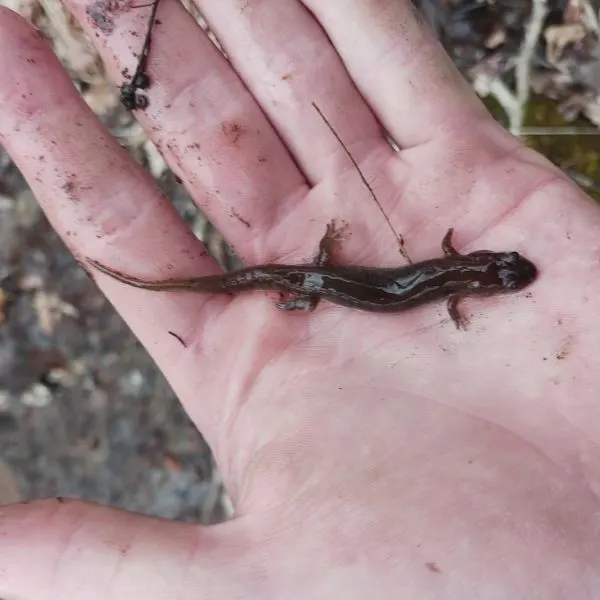
- Binomial Nomenclature: Desmognathus fuscus
- Adult Length: 2.5 to 4.5 inches
- Life expectancy: 10 to 15 years
- State Status: None
- Federal Status: None
Desmognathus fuscus is a lungless salamander and is in the family Plethodontidae. This species is similar to the southern dusky salamander although the latter is endemic to the southern portions of the United States.
Desmognathus fuscus is most common in the northern part of eastern North America. The range extends as far north as New Brunswick. The range extends to South Carolina in the south.
Desmognathus fuscus is a small and slender salamander. The background color of the dorsum is olive, gray, or reddish-brown/ the belly or ventrum is grey.
The upper body is of a darker color than the underside. There are dark spots on the sides and on the body and first part of the tail, there are two dark stripes or a light stripe. The species have 14 costal grooves and the hind legs are larger than the front legs.
The northern dusky salamander closely resembles the Allegheny Mountain dusky salamander. The Allegheny Mountain dusky has a tail that is rounded at the base while the northern dusky has a laterally compressed tail.
The species inhabits woodland streams, seepage, and springs. Here they are generally found in the water or along the water. They generally hide under logs, and rocks and as such as difficult to find.
6. Northern Two-lined Salamander
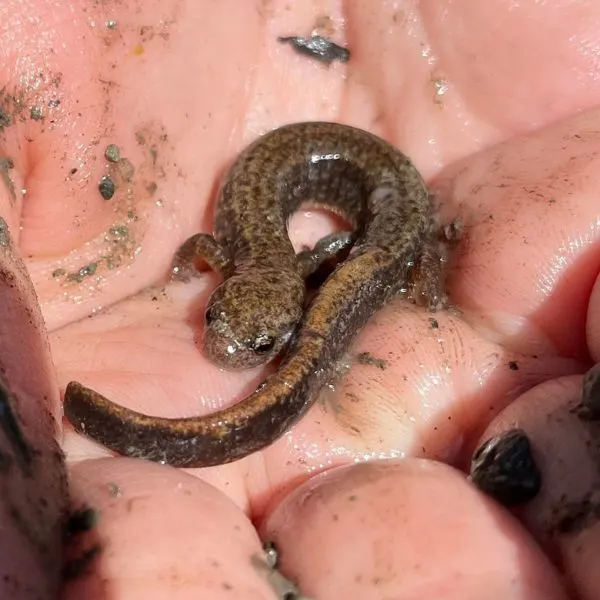
- Binomial Nomenclature: Eurycea bislineata
- Adult Length: 2.5 – 3 .75 inches
Eurycea bislineata is a small and slender salamander that is yellowish brown or just yellow with two dark stripes from the head to the tail. The stripes on the back and the geographic range give the species its common name.
The two lines on the back may be broken up, especially at the base of the take. For many individual northern two-lined salamanders, the line breaks at the base of the tail. In between the two strikes, there are several spots or blotches. The ventrum is yellow.
The species is endemic to Quebec, Labrador, and Ontario to Virginia. In Canada, It is also endemic to New Brunswick.
The species is endemic to seepages, springs, and rocky brooks. During the rainy seasons, you can find them in wooded habitats. The water bodies they inhabit are generally within mixed forests or deciduous forests.
The species is generally along stream banks although you can find some individuals several meters from the banks. Similar to other lungless salamanders, the two-lined salamander hides under ground cover such as leaf litter.
7. Spring Salamander

- Binomial Nomenclature: Gyrinophilus porphyriticus
- Adult Length: 4.75 to 7.5 inches
- Maximum Lifespan: 18.5 years
The spring salamander derives its name from one of its common habitats -springs. The species is also sometimes referred to as the purple salamander because it is purplish in coloration.
The species range extends from southern Quebec to northeastern Mississippi, Alabama, and northern Georgia. The species is endemic to the Appalachian Mountain range.
There are several species of Gyrinophilus porphyriticus. These include G. p. porphyriticus, G. p. duryi, G. p. danielsi, and G. p. dunni. The subspecies endemic to Massachusetts is G. p. porphyriticus which is the nominal subspecies. Individuals of the subspecies G. p. porphyriticus can reach a length of 9 inches although on average their length is 4.75 to 7.5 inches.
The dorsum of Gyrinophilus porphyriticus is pinkish or reddish to light brown or salmon. The color may have dark vague markings. These markings are difficult to notice.
The species inhabit springs – cool mountain springs more often than not. As a lungless salamander, the humidity and oxygen levels of its aquatic habitat must be high. During the rainy season, the species can be seen quite a distance from their usual habitat (springs and streams).
8. Four-toed Salamander
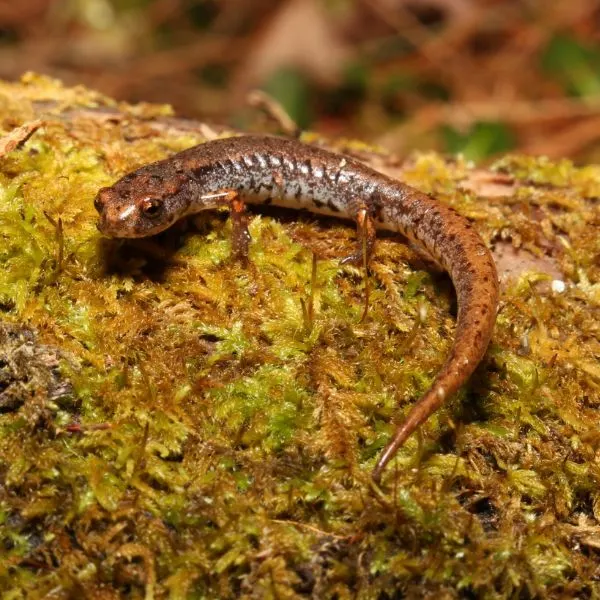
- Binomial Nomenclature: Hemidactylium scutatum
- Adult Male Length: 2 to 3 inches (5 to 7.6 cm)
- Adult Female Length: 2.8 to 3.5 inches (6.2 to 8.9 cm)
- State Status: Delisted
- Federal Status: None
Hemidactylium scutatum is the smallest salamander in the state. These amphibians have four toes on both hind and front limbs. Most salamanders have five toes on their hind limb. The other salamander within the state that also has four toes on its hind limb is the mudpuppy. The mudpuppy is however much bigger with an average of 8 to 13 inches. These also have bushy red gills.
The belly is enamel white with black speckles. The ventrum coloration is unique to the four-toed salamanders. The upper body is reddish brown and the sides are gray to black. Males are smaller and more slender than females.
The species is endemic to eastern North America from Quebec, Ontario, and Nova Scotia to Florida. Within Massachusetts, the species is endemic statewide although it is absent from Nantucket Island.
The species inhabited forested areas close to/ with aquatic sites such as marshes, bogs, swamps, and vernal pools. These use these aquatic habitats for breeding. These habitats must be without fish.
Adults often inhabit mature hardwood and coniferous forests. These salamanders remain well hidden under logs, leaf litter, bark and forests, and other cover objects on the forest floor.
During the winter, the species move to crevices in the ground such as channels, burrows, and holes.
9. Eastern Red-Backed Salamander
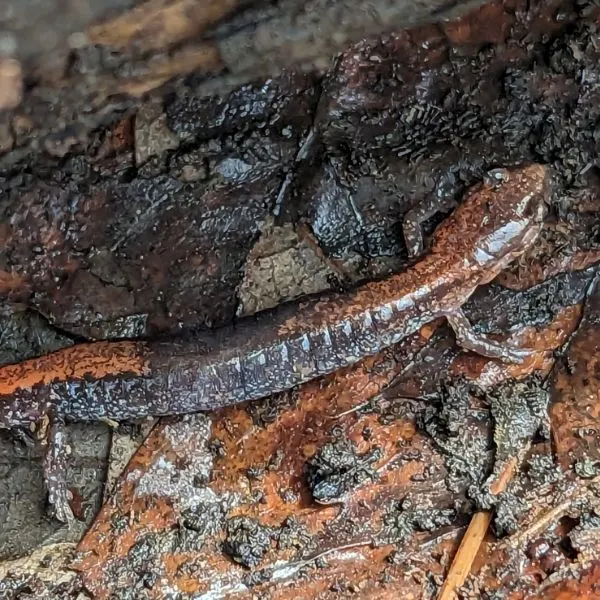
- Binomial Nomenclature: Plethodon cinereus
- Adult Length: 2.24 to 5.00 inches
- Lifespan: 25 years in captivity
The red-backed salamander is a small salamander with a red stripe down its back. This salamander sometimes is gray in coloration with no red stripe down the back. Individuals with this coloration are referred to as leadback. The red-backed salamander is also known as the northern red-backed salamander, the redback salamander, and the eastern red-backed salamander.
Plethodon cinereus is a small amphibian reaching a length of about 4 inches at most, including the tail. It is quite common within its geographic range.
Similar to other amphibians within the family Plethodontidae, Plethodon cinereus has no lungs instead it relies on cutaneous respiration. Here it respires through the skin. Because of this, the species require habitats with high humidity and close proximity to a water body, such as a stream, with high oxygen levels.
The species is endemic to Eastern North America. The geographic range extends from Quebec to North Carolina.
Family Proteidae
10. Mudpuppy
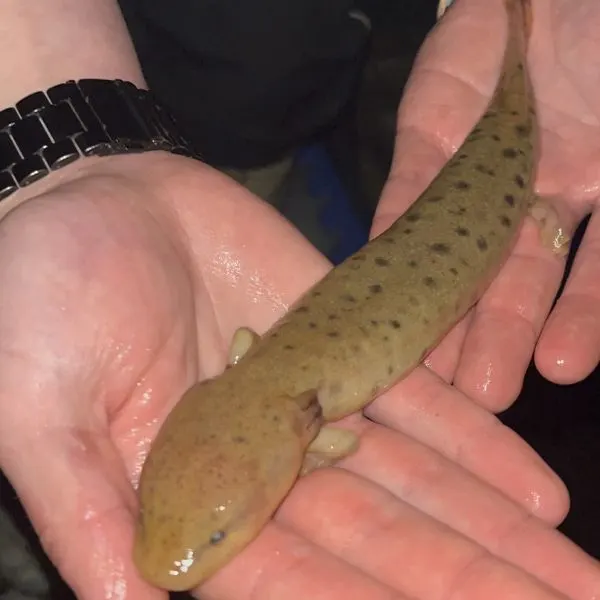
- Binomial Nomenclature: Necturus maculosus
- Adult Length: 7.9 to 13 inches (20 to 33 cm)
- Lifespan: 20 years
This species is endemic to eastern North America. Here their geographic range starts as far north as Manitoba and southern Quebec. The range extends to Massachusetts, Rhode Island, new york, Connecticut, south-central Kansas, central Missouri, southern Illinois, and extreme northern Kentucky.
Within its geographic range, the mudpuppy inhabits freshwater. They are purely aquatic and are unable to cross upland habitats. Its habitats include permanent streams, lake lakes, weedy ponds, and rivers.
Compared to other salamanders, the mudpuppy is large. It reaches a length of over a foot. It has large bushy gills which are reddish. The coloration of its dorsum is rusty brown, grayish to blackish. There are several dark spots and blotches on the skin.
The species is neotenic. They go through paedomorphosis and keep their external gills, unlike most other salamanders that undergo metamorphosis.
Family Salamandridae
11. Eastern Newt
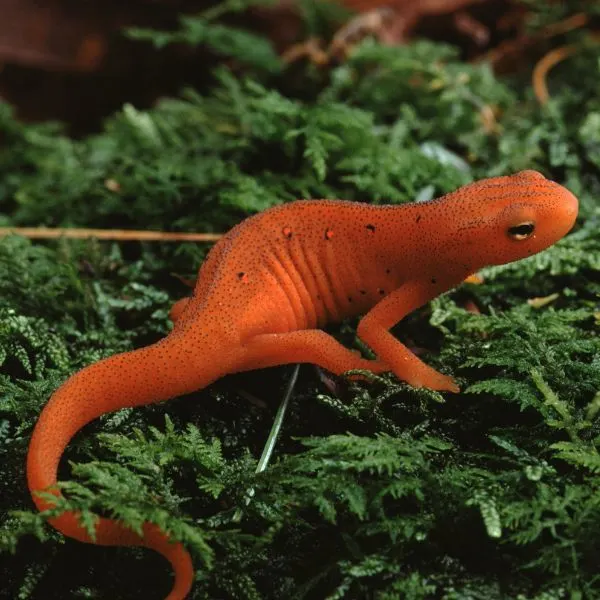
- Binomial Nomenclature: Notophthalmus viridescens
- Adult Length: 2.8 to 4.9 inches (7 to 12.4 cm)
- Lifespan: 15 years
The eastern newt is endemic to most of eastern North America. Its range starts from southern Canada to Texas. In Massachusetts, the newt occurs statewide.
There are four subspecies namely – N. v. viridescens, N. v. louisianensis, N. v. dorsalis, and N. v. piaropicola. The subspecies endemic to Massachuseet is N. v. viridescens. This subspecies is known as the red-spotted newt.
In the wild, the eastern newt lives to an age of 8 to 10 years on average. Some have been known to reach the age of 15 years.
The eastern newt starts as aquatic larvae. They then develop into red efts. Finally, they develop into adult newts.
The larvae which is the first stage have gills. These are greenish brown. They lose their gills once they become efts.
The eft stage is the terrestrial and intermediate stage. In this stage, the species is bright red. In Massachusetts, the eft moves over an area of about 270 sq meters. The efts have highly toxic skin secretions. Unlike most other salamanders, red efts do not hide during the day. Instead, they rely on their highly toxic skin as a defense against predators. As such they have few predators.
As adults, they are greenish brown or yellowish brown with several red spots with black borders. Their underside / ventrum is yellow with red speckles. As adults, they are aquatic. They are generally permanently aquatic but some individuals are known to leave the water in summer or fall.
Frequently Asked Questions
Are salamanders protected in Massachusetts?
Several salamanders are protected in Massachusetts. These are the endangered or threatened species. The protected salamanders are the Jefferson salamander, blue-spotted salamander, and marbled salamander.
How can you tell a salamander from a newt?
While newts are salamanders, you may want to be able to tell a newt from other salamanders as the newts within Massachusetts are highly toxic and the other salamander. The is only one newt species within the state and that is the eastern newt. These newts have three stages. They can be larvae, efts, and aquatic adults.
As efts, they are highly toxic. Unlike other salamanders, they don’t hide under rocks, logs, and other ground covers. They are bright orangish red to red. This makes them easy to identify.
As adults, they are greenish brown or yellowish brown with several red spots with black borders.
Is a salamander a reptile or an amphibian?
Salamanders may resemble lizards, but they are amphibians. As such, they are more closely related to frogs and toads than they are to lizards.
Where do salamanders live?
Most salamanders are semi-terrestrial as adults. They can be found in springs, streams, lakes, rivers, and areas surrounding these water bodies. The eastern newt and the mudpuppy are the two aquatic salamanders within the stage. The others are either semi-terrestrial or semi-aquatic.
Conclusion
There are about eleven salamanders within the state. Out of these, there are two fully aquatic species and these are the mudpuppy and the adult eastern newt. Mudpuppies are aquatic their entire life but eastern newts are aquatic as larvae and adults.
The salamanders within the state are of four families and these are Ambystomatidae, Plethodontidae, Proteidae, and Salamandridae. Proteidae includes mud puppies and water dogs. Salamandridae includes newts. Plethodontidae includes lungless salamanders which rely on cutaneous respiration. Ambystomatidae refers to mole salamanders which are stout, unlike most other salamanders which are slender.
Salamanders can be found throughout the entire state although they generally remain hidden.
Other nearby states
